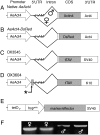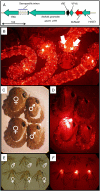Female-specific flightless phenotype for mosquito control
- PMID: 20176967
- PMCID: PMC2826341
- DOI: 10.1073/pnas.1000251107
Female-specific flightless phenotype for mosquito control
Erratum in
- Proc Natl Acad Sci U S A. 2010 Oct 26;107(43):18741
Abstract
Dengue and dengue hemorrhagic fever are increasing public health problems with an estimated 50-100 million new infections each year. Aedes aegypti is the major vector of dengue viruses in its range and control of this mosquito would reduce significantly human morbidity and mortality. Present mosquito control methods are not sufficiently effective and new approaches are needed urgently. A "sterile-male-release" strategy based on the release of mosquitoes carrying a conditional dominant lethal gene is an attractive new control methodology. Transgenic strains of Aedes aegypti were engineered to have a repressible female-specific flightless phenotype using either two separate transgenes or a single transgene, based on the use of a female-specific indirect flight muscle promoter from the Aedes aegypti Actin-4 gene. These strains eliminate the need for sterilization by irradiation, permit male-only release ("genetic sexing"), and enable the release of eggs instead of adults. Furthermore, these strains are expected to facilitate area-wide control or elimination of dengue if adopted as part of an integrated pest management strategy.
Conflict of interest statement
The authors declare no conflict of interest.
Figures


References
-
- Remme J, et al. Strategic emphases for tropical diseases research: A TDR perspective. Trends Parasitol. 2002;18(10):421–426. - PubMed
-
- World Health Organization Special Programme for Research and Training in Tropical Diseases. Scientific Working Group Report on Dengue. Geneva: WHO; 2006. p. 162.
-
- Knipling E. Possibilities of insect control or eradication through use of sexually sterile males. J Econ Entomol. 1955;48:459–462.
-
- Dyck V, Hendrichs J, Robinson AS, editors. Sterile Insect Technique: Principles and Practice in Area-Wide Integrated Pest Management. Dordrecht, The Netherlands: Springer; 2005. pp. 1–787.
Publication types
MeSH terms
Substances
LinkOut - more resources
Full Text Sources
Other Literature Sources

